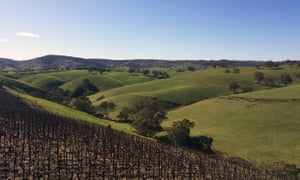 |
| The high altitude of the Siegersdorf vineyard protects its grape harvest from the extreme heat of the South Australian summer. Photograph: Adam Brereton for the Guardian |
Urban redevelopment, quirky little bars, experimental wineries in the Barossa. This once sleepy city and its surrounds are having a moment in the sun
I knew Adelaide had a reputation for staid conservatism before my first visit, but it didn’t hit home until I was wandering the city’s streets in a nicotine-deprived stupor at 6pm on a Sunday, desperately searching for somewhere to buy cigarettes.
“Welcome to Adelaide!” my friends messaged me. Yeah, yeah.
My arrival had been much more congenial: a perfect powder blue sky and the promise that the place was on the up and up. Between the rejuvenation of Adelaide’s restaurant and bar scene, the broadening of the Barossa’s appeal beyond wine sales at the cellar door and the redevelopment of the Adelaide Oval sports precinct, the southern capital was, I had been told, having its moment in the sun.
My short-lived nicotine quest aside, 48 hours there confirmed this was, indeed, the case.
Sunday
1pm: lunch at 2KW Bar & Restaurant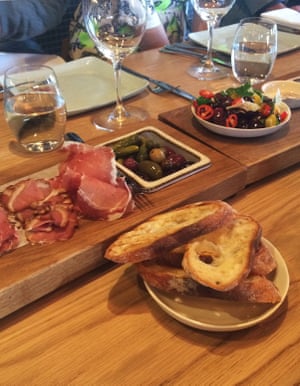
2pm: hoofin’ it around Adelaide
Adelaide is pretty flat. That’s great if you like to walk, which I do. The city was flooded with Crows and Port supporters heading to the newly developed park to watch the game on a big screen and eat from food trucks. I went for a wander to check out the city’s famous churches, which really are beautiful. Perhaps I’d overdosed on Lutheranism but Victoria Square, the open and austere city centre, felt more like a Victoriaplatz. The mild culture shock had me wondering about Sydney’s residual Irishisms.
7pm: dinner at Street ADL
Back to the food. To call ADL eclectic would be an understatement. Alongside the ubiquitous share plates, this time a mixed bag of street food – ceviche, bruschetta, sang choi bow, quesadillas – is a kind of Australiana sub-menu of roasted pumpkin, saltbush and macadamia nuts, eucalyptus-smoked lamb and so on. Then there’s food truck standards such as mac-and-cheese-burgers and roasted corn cobs ... it’s as if the chefs are trying to run with half a dozen food trends at once. As far as pub grub goes, it was pretty hearty. Better was the country and western singer who ripped out a solid Jolene on request. Even better was the decent range of bottled beers (I couldn’t face any more grape juice).
9pm: small bars of Adelaide
Redrawn licensing laws, in force from 2013, set off Adelaide’s small bar scene. Along Peel Street, there are a few joints that would not seem amiss in the trendier parts of Melbourne or Sydney: Clever Little Tailor, all wood panels and snug booths; Udaberri Pintxos y Vino, which serves Spanish nibbles and cocktails; and Maybe Mae, which follows the speakeasy trend by disguising its entrance behind a wood panel in a staircase. I managed a few mugs of porter before well and truly hitting a wall and beating a retreat back to the hotel.
Monday
8am: wine wine wineAfter a solid day of eating and drinking in Adelaide, it was time for a change of pace: eating and drinking in the Barossa Valley. The region has long been known as Australia’s prime region for grape-growing, winemaking and Germans, but is being transformed in subtle and interesting ways. There are innovative small vineyards flourishing in the shadow of the all-consuming Jacob’s Creek industrial complex and the area is becoming a foodie paradise, as you may have guessed from that Nick Cave tourism advert where they roll around in the dirt.
I joined a tour group run by Life is a Cabernet, whose owner, Ralf Hadzic, used to be the guy in the cat suit on popular TV show Fat Cat and Friends. His jokes were pretty salty, which only intensified my raging thirst ... for wine.
Ballycroft Vineyard and Cellars was the first stop. Owner and winemaker Joe Evans is a stickler for quality, letting the soil and sun do their work while he keeps a close eye on the grapes. He’s big on permaculture too and, during a foray into cheesemaking, sprayed whey on the vines to control pests.
Ballycroft’s “small berry” shiraz is the result of careful cultivation; rather than overwatering, leading to high berry weight, Evans aims for less juice and more flavour and colour from the skins. The cellar-door experience was wonderful – this winemaker knows how to spruik his wares and there was plenty to taste too. Eftpos is, luckily, available on site.
10am: morning tea at Tanunda bakery
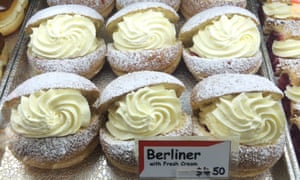
Other traditional practices continue too. At Tanunda bakery, a local institution, there is a mind-boggling selection of bread, German doughnuts and strudels. The coffee was good, too, in that frothy European style. Bring a working pancreas and an appetite for whipped cream and icing sugar.
11am: riesling tasting at Siegersdorf lookout
The amazing Siegersdorf lookout – a high-altitude vineyard planted, improbably, on limestone – escapes the worst of the summer heat and moisture and produces the nicest riesling I think I’ve ever tasted. Looking out over the rolling green hills, you’d have no idea that, at the top of summer, it frequently peaks above 40C down on the flat. The wine itself was really delicate with a nice fruity mid-palate and a bit of fizz. Just wonderful and not that expensive to order online.
12pm: lunch at Artisans of Barossa
Six wineries comprise the Artisans of Barossa, a co-operative cellar door/restaurant. They’re all subregional winemakers, some older and some younger, and there’s loads on offer as far as variety and price is concerned. The restaurant, Harvest Kitchen, opened in March 2015 with MasterChef contestant Tracy Collins at the helm.
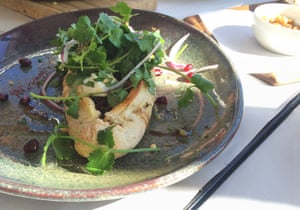
Looking out over the vineyards as you graze through all the produce on offer, one thought does pass through your mind: by now it would be highly illegal for me to drive.
2pm: Maggie Beer’s farm shop
Maggie Beer’s little pates, spreads and quince pastes are a staple of cheeseboards everywhere and, if you visit her farm store, you can taste as much as you want. The store, beside a charming dam, has coffee and more substantial food on offer, while peacocks freely cavort in the car park. Truth be told, I was too full from lunch to properly appreciate it and had already bought enough wine to cart around. Perhaps it would be wise to schedule a visit in the morning – before you’re bursting at the seams and hankering for a nap.
2:30pm: Tscharke’s Place
By the time we arrived at Tscharke’s Place, my capacity to drink loads more wine had been miraculously restored. The winery is a fascinating interweaving of history and modernity; the Tscharke family can trace their Barossa roots to Prussian immigrants who bought land in the area in 1869 and the hi-tech winery is adorned with old family photos.
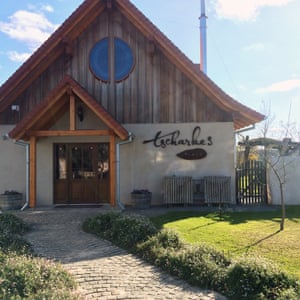
The tasting, held in a separate underground room below the main house, was great fun. Experimental “emerging wines” can be had for a steal too. We tried Eva Frizzante, a sweet fizzy white made for a German palate and named for Damien’s wife (and drunk in decent quantities at their wedding, we were told).
7pm: a game
The Adelaide Oval redevelopment has been a huge deal for the cityscape, bringing footy and soccer into a central position. Team signings in Rundle Mall are now only a short walk across the footbridge from the stadium, which hosts high-profile international matches. Liverpool FC played Adelaide FC in an exhibition game in July, and the stadium will host a World Cup qualifier with the Socceroos in March. If you’re a sports fanatic, you’ll already know all this and the revitalised scene in Adelaide will make your trip a treat.
No comments:
Post a Comment